2007 CHEVROLET EQUINOX key
[x] Cancel search: keyPage 1 of 492
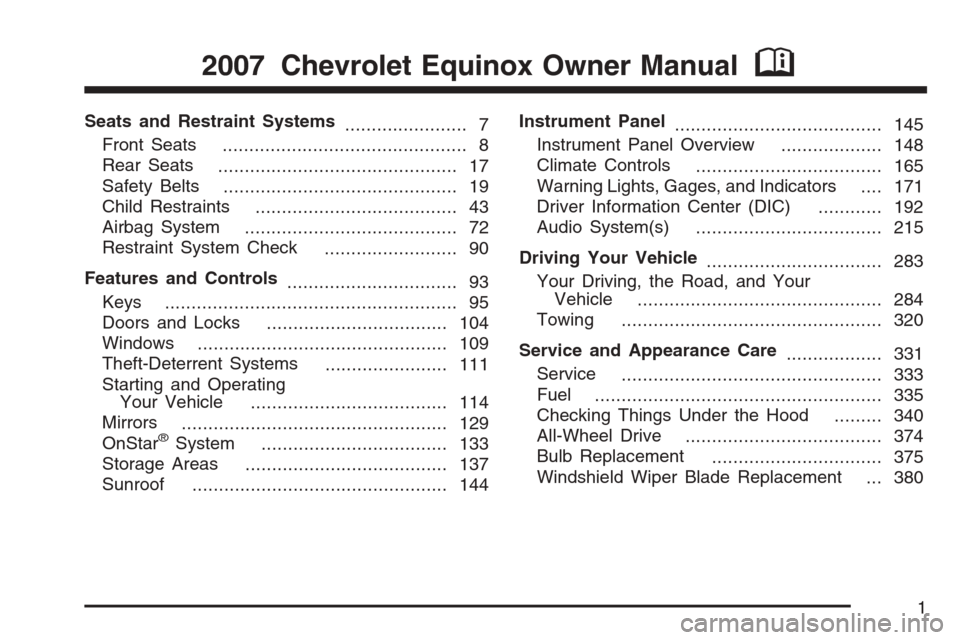
Seats and Restraint Systems
....................... 7
Front Seats
.............................................. 8
Rear Seats
............................................. 17
Safety Belts
............................................ 19
Child Restraints
...................................... 43
Airbag System
........................................ 72
Restraint System Check
......................... 90
Features and Controls
................................ 93
Keys
....................................................... 95
Doors and Locks
.................................. 104
Windows
............................................... 109
Theft-Deterrent Systems
....................... 111
Starting and Operating
Your Vehicle
..................................... 114
Mirrors
.................................................. 129
OnStar
®System
................................... 133
Storage Areas
...................................... 137
Sunroof
................................................ 144Instrument Panel
....................................... 145
Instrument Panel Overview
................... 148
Climate Controls
................................... 165
Warning Lights, Gages, and Indicators
.... 171
Driver Information Center (DIC)
............ 192
Audio System(s)
................................... 215
Driving Your Vehicle
................................. 283
Your Driving, the Road, and Your
Vehicle
.............................................. 284
Towing
................................................. 320
Service and Appearance Care
.................. 331
Service
................................................. 333
Fuel
...................................................... 335
Checking Things Under the Hood
......... 340
All-Wheel Drive
..................................... 374
Bulb Replacement
................................ 375
Windshield Wiper Blade Replacement
... 380
2007 Chevrolet Equinox Owner ManualM
1
Page 35 of 492
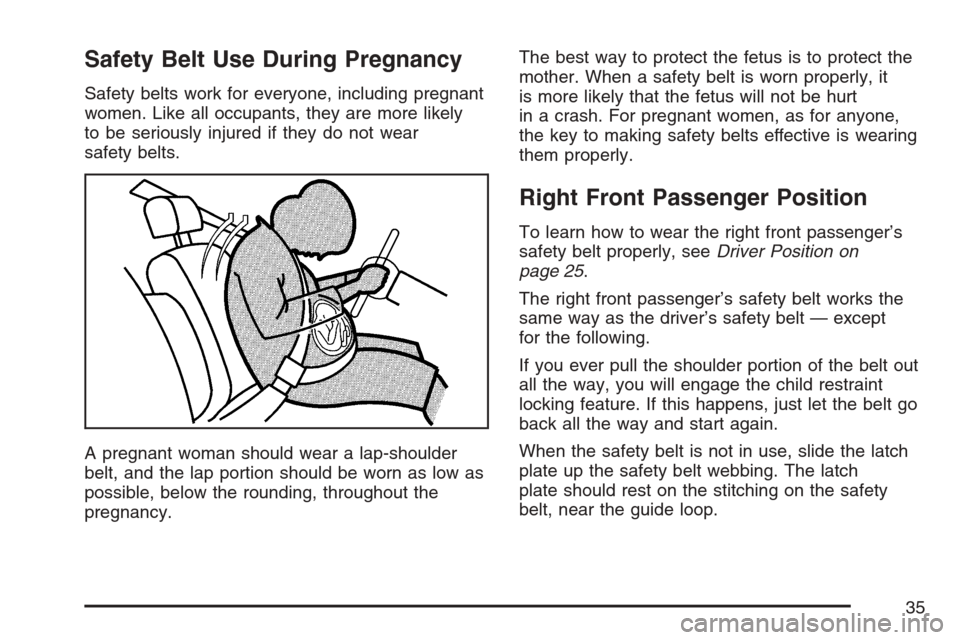
Safety Belt Use During Pregnancy
Safety belts work for everyone, including pregnant
women. Like all occupants, they are more likely
to be seriously injured if they do not wear
safety belts.
A pregnant woman should wear a lap-shoulder
belt, and the lap portion should be worn as low as
possible, below the rounding, throughout the
pregnancy.The best way to protect the fetus is to protect the
mother. When a safety belt is worn properly, it
is more likely that the fetus will not be hurt
in a crash. For pregnant women, as for anyone,
the key to making safety belts effective is wearing
them properly.
Right Front Passenger Position
To learn how to wear the right front passenger’s
safety belt properly, seeDriver Position on
page 25.
The right front passenger’s safety belt works the
same way as the driver’s safety belt — except
for the following.
If you ever pull the shoulder portion of the belt out
all the way, you will engage the child restraint
locking feature. If this happens, just let the belt go
back all the way and start again.
When the safety belt is not in use, slide the latch
plate up the safety belt webbing. The latch
plate should rest on the stitching on the safety
belt, near the guide loop.
35
Page 71 of 492
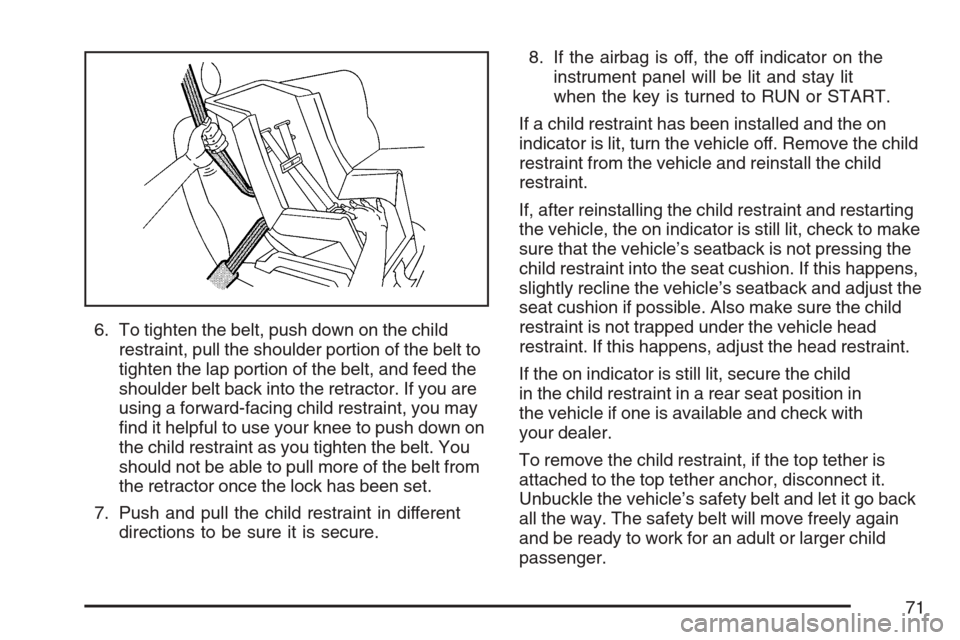
6. To tighten the belt, push down on the child
restraint, pull the shoulder portion of the belt to
tighten the lap portion of the belt, and feed the
shoulder belt back into the retractor. If you are
using a forward-facing child restraint, you may
�nd it helpful to use your knee to push down on
the child restraint as you tighten the belt. You
should not be able to pull more of the belt from
the retractor once the lock has been set.
7. Push and pull the child restraint in different
directions to be sure it is secure.8. If the airbag is off, the off indicator on the
instrument panel will be lit and stay lit
when the key is turned to RUN or START.
If a child restraint has been installed and the on
indicator is lit, turn the vehicle off. Remove the child
restraint from the vehicle and reinstall the child
restraint.
If, after reinstalling the child restraint and restarting
the vehicle, the on indicator is still lit, check to make
sure that the vehicle’s seatback is not pressing the
child restraint into the seat cushion. If this happens,
slightly recline the vehicle’s seatback and adjust the
seat cushion if possible. Also make sure the child
restraint is not trapped under the vehicle head
restraint. If this happens, adjust the head restraint.
If the on indicator is still lit, secure the child
in the child restraint in a rear seat position in
the vehicle if one is available and check with
your dealer.
To remove the child restraint, if the top tether is
attached to the top tether anchor, disconnect it.
Unbuckle the vehicle’s safety belt and let it go back
all the way. The safety belt will move freely again
and be ready to work for an adult or larger child
passenger.
71
Page 82 of 492
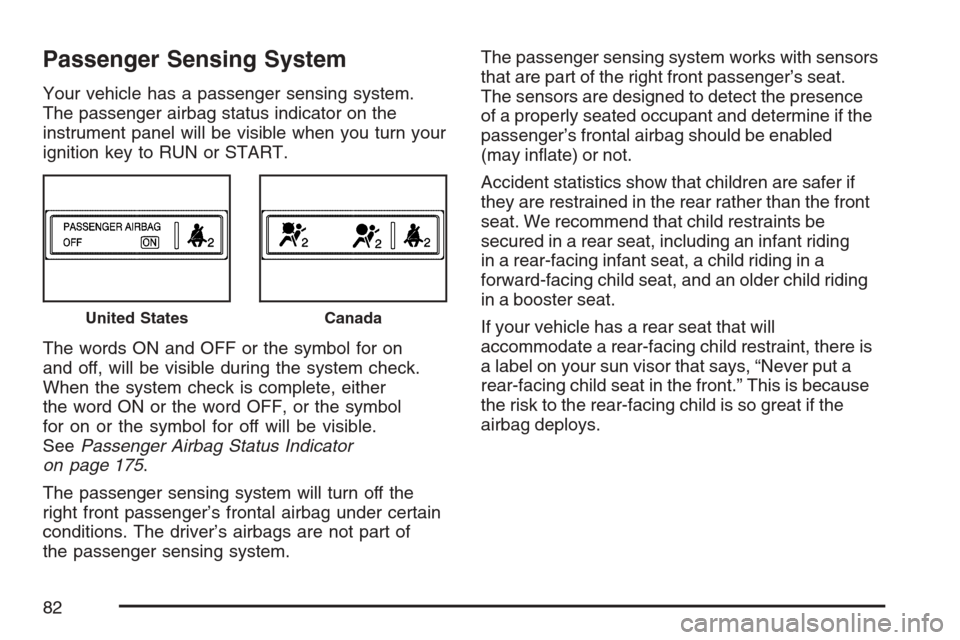
Passenger Sensing System
Your vehicle has a passenger sensing system.
The passenger airbag status indicator on the
instrument panel will be visible when you turn your
ignition key to RUN or START.
The words ON and OFF or the symbol for on
and off, will be visible during the system check.
When the system check is complete, either
the word ON or the word OFF, or the symbol
for on or the symbol for off will be visible.
SeePassenger Airbag Status Indicator
on page 175.
The passenger sensing system will turn off the
right front passenger’s frontal airbag under certain
conditions. The driver’s airbags are not part of
the passenger sensing system.The passenger sensing system works with sensors
that are part of the right front passenger’s seat.
The sensors are designed to detect the presence
of a properly seated occupant and determine if the
passenger’s frontal airbag should be enabled
(may in�ate) or not.
Accident statistics show that children are safer if
they are restrained in the rear rather than the front
seat. We recommend that child restraints be
secured in a rear seat, including an infant riding
in a rear-facing infant seat, a child riding in a
forward-facing child seat, and an older child riding
in a booster seat.
If your vehicle has a rear seat that will
accommodate a rear-facing child restraint, there is
a label on your sun visor that says, “Never put a
rear-facing child seat in the front.” This is because
the risk to the rear-facing child is so great if the
airbag deploys.
United StatesCanada
82
Page 93 of 492

Keys.............................................................. 95
Remote Keyless Entry (RKE) System.......... 96
Remote Keyless Entry (RKE)
System Operation.................................... 97
Doors and Locks........................................ 104
Door Locks................................................ 104
Power Door Locks..................................... 105
Delayed Locking........................................ 105
Programmable Automatic Door Locks........ 105
Rear Door Security Locks......................... 106
Lockout Protection..................................... 106
Liftgate...................................................... 107
Windows...................................................... 109
Power Windows........................................ 110
Sun Visors................................................ 110
Theft-Deterrent Systems............................. 111
Content Theft-Deterrent............................. 111
PASS-Key
®III+......................................... 112
PASS-Key®III+ Operation......................... 113Starting and Operating Your Vehicle......... 114
New Vehicle Break-In................................ 114
Ignition Positions....................................... 115
Retained Accessory Power (RAP)............. 116
Starting the Engine.................................... 116
Engine Coolant Heater.............................. 118
Automatic Transaxle Operation.................. 119
Parking Brake........................................... 122
Shifting Into Park (P) ................................. 123
Shifting Out of Park (P)............................. 125
Parking Over Things That Burn................. 126
Engine Exhaust......................................... 127
Running the Engine While Parked............. 128
Section 2 Features and Controls
93
Page 95 of 492

Keys
{CAUTION:
Leaving children in a vehicle with the
ignition key is dangerous for many
reasons. They could operate the power
windows or other controls or even make
the vehicle move. The children or others
could be badly injured or even killed.
Do not leave the keys in a vehicle with
children.
95
Page 96 of 492
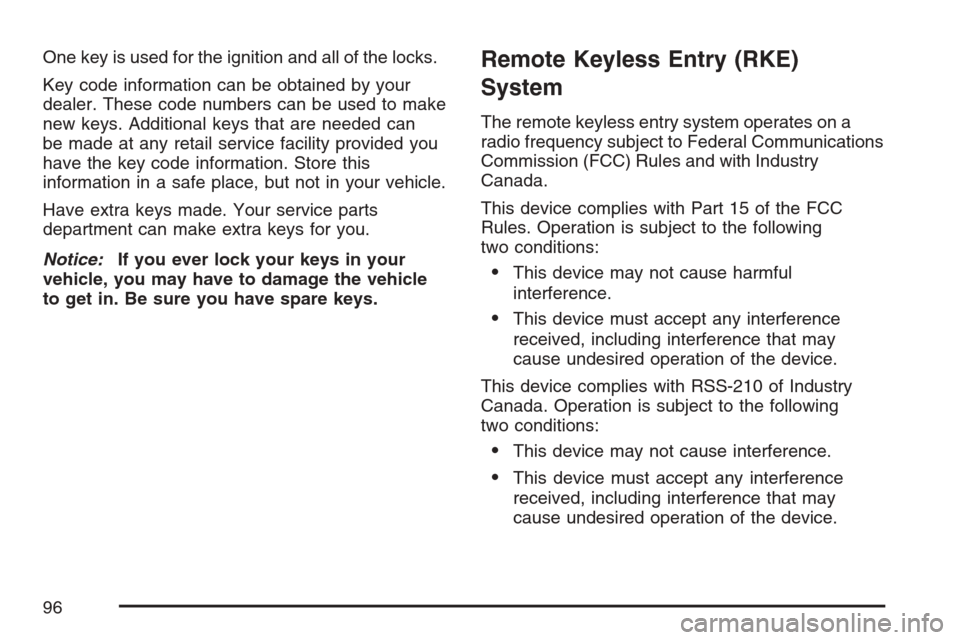
One key is used for the ignition and all of the locks.
Key code information can be obtained by your
dealer. These code numbers can be used to make
new keys. Additional keys that are needed can
be made at any retail service facility provided you
have the key code information. Store this
information in a safe place, but not in your vehicle.
Have extra keys made. Your service parts
department can make extra keys for you.
Notice:If you ever lock your keys in your
vehicle, you may have to damage the vehicle
to get in. Be sure you have spare keys.Remote Keyless Entry (RKE)
System
The remote keyless entry system operates on a
radio frequency subject to Federal Communications
Commission (FCC) Rules and with Industry
Canada.
This device complies with Part 15 of the FCC
Rules. Operation is subject to the following
two conditions:
This device may not cause harmful
interference.
This device must accept any interference
received, including interference that may
cause undesired operation of the device.
This device complies with RSS-210 of Industry
Canada. Operation is subject to the following
two conditions:
This device may not cause interference.
This device must accept any interference
received, including interference that may
cause undesired operation of the device.
96
Page 97 of 492
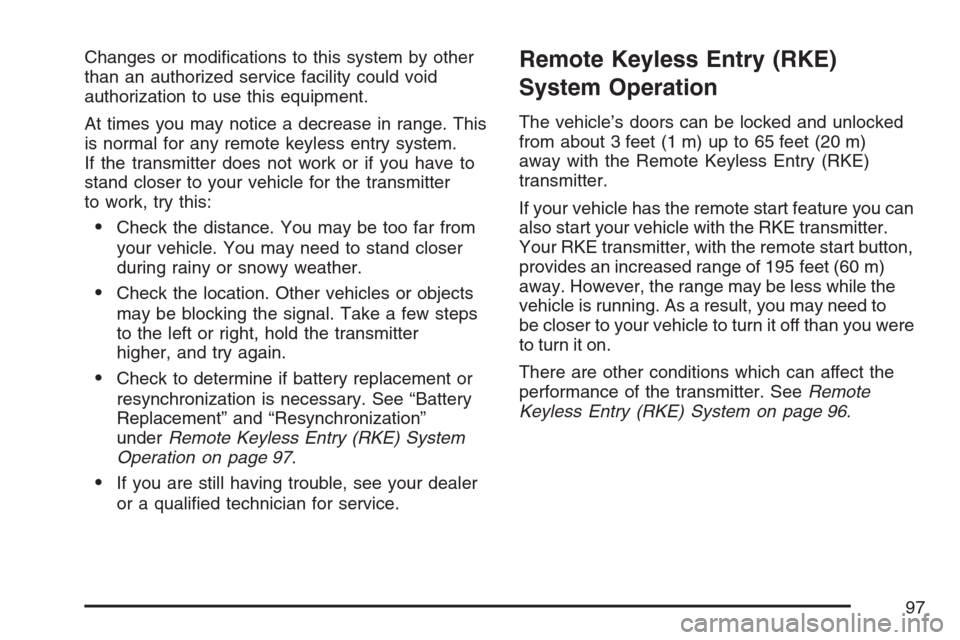
Changes or modi�cations to this system by other
than an authorized service facility could void
authorization to use this equipment.
At times you may notice a decrease in range. This
is normal for any remote keyless entry system.
If the transmitter does not work or if you have to
stand closer to your vehicle for the transmitter
to work, try this:
Check the distance. You may be too far from
your vehicle. You may need to stand closer
during rainy or snowy weather.
Check the location. Other vehicles or objects
may be blocking the signal. Take a few steps
to the left or right, hold the transmitter
higher, and try again.
Check to determine if battery replacement or
resynchronization is necessary. See “Battery
Replacement” and “Resynchronization”
underRemote Keyless Entry (RKE) System
Operation on page 97.
If you are still having trouble, see your dealer
or a quali�ed technician for service.
Remote Keyless Entry (RKE)
System Operation
The vehicle’s doors can be locked and unlocked
from about 3 feet (1 m) up to 65 feet (20 m)
away with the Remote Keyless Entry (RKE)
transmitter.
If your vehicle has the remote start feature you can
also start your vehicle with the RKE transmitter.
Your RKE transmitter, with the remote start button,
provides an increased range of 195 feet (60 m)
away. However, the range may be less while the
vehicle is running. As a result, you may need to
be closer to your vehicle to turn it off than you were
to turn it on.
There are other conditions which can affect the
performance of the transmitter. SeeRemote
Keyless Entry (RKE) System on page 96.
97